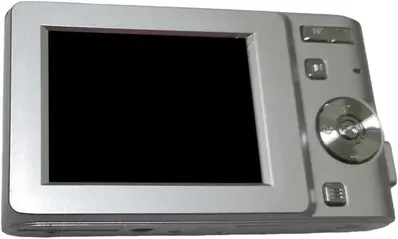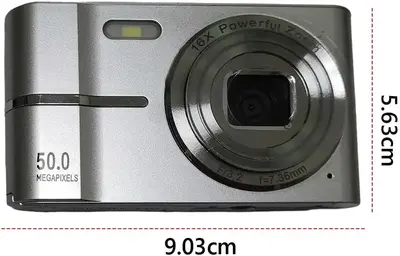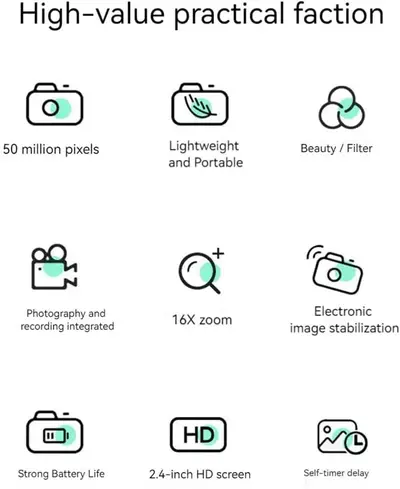
Generic Camera digital compact
| Brand | Generic 1990 |
| Model | digicam |
| Released Year | 1990 |
| Type | Point & Shoot Digital Cameras |
| Color | Silver |
| Compatible Mountings | Sony E |
| Photo Sensor Resolution | 1.42 MP |
| Video Resolution | 1080p |
| Optical Zoom | 1 x |
| File Format | JPEG |
| Status | Discontinued |
Quick view
Overview
The Generic Digital Compact Camera, often recognized as one of the early digital compact cameras, features a basic CCD image sensor that allows for modest resolution image capture, typically ranging from 0.3 to 2 megapixels depending on the exact model variant. The device employs a fixed or limited zoom lens, ideal for casual photography during the onset of the digital camera era. Connectivity options are limited, commonly including serial or USB ports for data transfer, with storage support using CompactFlash or SmartMedia cards. Power is supplied by removable AA batteries or proprietary lithium-ion battery packs, balancing portability and usage time. Image file formats are usually JPEG, allowing for basic compression and ease of use with early photo editing software. The camera's form factor is compact and lightweight, making it suitable for everyday casual photography despite its limited advanced features.
Optical viewfinders or small LCD screens assist in framing shots, although the screen resolution and refresh rates are quite basic compared to modern standards. The device typically includes automatic exposure and white balance settings, with minimal manual control options for aperture or shutter speed, aimed primarily at novice users. Flash units, either built-in or attachable, supplement low-light conditions, albeit with limited range and effectiveness. The design reflects an early transition from analog to digital imaging technology, marking it as a pioneer in convenient digital photography solutions for consumers.
Specifications
| Built-In Media | 1 x Camera, 1 x Charging Cable |
| Are Batteries Included | No |
| Manufacturer | digicam |
| Warranty Description | 1 year |
| Compatible Mountings | Sony E |
| Sensor Type | CCD |
| Image stabilization | Digital |
| Photo Sensor Resolution | 1.42 MP |
| Photo Sensor Size | 1/2.3-inch |
| Color | Silver |
| Item Weight | 0.4 Pounds |
| Video Resolution | 1080p |
| Aspect Ratio | 1.29:1 |
| File Format | JPEG |
| Effective Still Resolution | 20 MP |
| Optical Zoom | 1 x |
| Lens Type | Wide Angle |
| Lens Construction | Fixed lens |
| Connectivity Technology | Auxiliary |
| Screen Size | 0.96 Inches |
| Display Type | LED |
| Display Fixture Type | Fixed |
| Display Resolution Maximum | 4K MP |
| Image Sensor | CCD sensor, approx. 0.3 to 2 megapixels |
| Lens | Fixed or limited zoom lens |
| Storage Media | CompactFlash or SmartMedia card |
| Connectivity | Serial or USB port |
| Power Supply | Removable AA batteries or proprietary lithium-ion battery |
| Image Format | JPEG |
| Display | Small LCD screen with low resolution |
| Viewfinder | Optical viewfinder |
| Manual Controls | Minimal; mostly automatic exposure and white balance |
| Flash | Built-in or attachable flash unit |
| Dimensions | Compact and lightweight design |
Images
Key Advantages
The Generic Digital Compact Camera offers exceptional portability due to its compact size and lightweight build, making it easy to carry for casual photography. It provides instant digital image capture and review, eliminating the need for film development, which was a significant advantage during its release period. The camera's simple user interface caters well to beginners and users unfamiliar with complex photography settings. Additionally, the use of removable storage media allowed for flexible image saving and transfer to computers. Its compatibility with standard batteries adds convenience and ease of battery replacement worldwide. The relatively affordable pricing made digital photography accessible to a broader audience compared to advanced DSLR cameras of the time.
Limitations
This camera suffers from relatively low image resolution and limited sensor performance, producing images with noticeable noise and reduced detail in low-light conditions. The fixed or minimal zoom capability restricts versatility in framing and composition, limiting creative photographic options. It lacks advanced manual controls such as adjustable aperture, shutter speed, and ISO settings, which constrains photographers who desire more creative control. The limited storage capacity and slower data transfer speeds typical of early digital storage media can hinder workflow efficiency. Battery life is often short due to power-hungry components and reliance on AA batteries or early lithium-ion technology. The LCD display features low resolution and limited visibility in bright outdoor conditions, complicating picture review and camera operation.
FAQ
What type of image sensor does the Generic Digital Compact Camera use?
It typically uses a CCD (Charge-Coupled Device) sensor common in early digital cameras.
What kind of storage media is compatible with this camera?
The camera usually supports CompactFlash or SmartMedia cards for image storage.
Does this camera offer manual controls for photography settings?
No, it primarily offers automatic exposure and white balance with minimal to no manual control.
What are the power options for this camera?
Power is supplied by removable AA batteries or proprietary lithium-ion battery packs.
Can images be transferred to a computer directly?
Yes, via serial or USB ports depending on the specific model variant.
Is there an LCD screen for image review?
Yes, but the screen resolution is low and may be difficult to see in bright light.
Is this camera still in production?
No, the Generic Digital Compact Camera has been discontinued and is considered a vintage device.
Disclaimer
The content on is provided for general informational purposes only. We do not guarantee the accuracy, completeness, or reliability of any information, specifications, or visuals presented on the site.
is not responsible for any content, images, or data uploaded or shared by users. Users are solely responsible for the content they submit.
We may include links to third-party websites for convenience. We do not endorse or take responsibility for the content or policies of any external sites.
Use of the site is at your own risk. Always verify critical information independently before making decisions based on content from this website.








